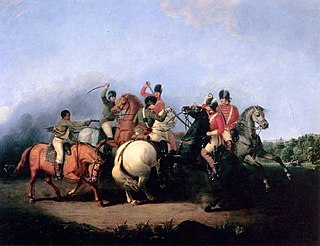The Catawba in the American Civil War participated in the Eastern Theater. [1] From the very beginning, the Catawba allied themselves with the Confederacy, remaining loyal until the end of the War. They enrolled with the 5th, 12th, and 17th South Carolina Infantry Regiments. [1] [2]
The Catawba people live in the South Carolina region, as they did prior to European contact. [3] The Catawba call themselves, "yeh is-WAH h’reh" or "People of the River." [3]
The earliest documented European contact occurred when Hernando de Soto's Spanish expedition reached the Piedmont plateau. [3] There would be no colonial contact for almost 100 years after the "De Soto Entrada."
As European settlers established themselves along the eastern coast, the Catawba became experienced traders. The deer skin market helped the Catawba receive European goods like muskets, iron knives, kettles, and cloth [3] but also brought along disease and encroachment.
In 1747, the Province of South Carolina allotted the Catawba 15 square miles in the York and Lancaster districts. [4]
American colonists considered the Catawba "the best friends the colonist had." [5] When the Revolutionary War started, there were between 1,000 [3] to 5,000 or more Catawbas. [6] It is said that more than 500 lost their lives during the Revolutionary War. [6] The Catawbas served under General Lee's Legion and fought with him in 1780. [4] For siding with the Americans during the revolution, the British destroyed the Catawba's major village. [7]
On March 13 of 1840, a treaty was made between South Carolina and the Catawba. [4] [8] At that time, their delegation at the signing was recorded as 12 men, 36 women, and 40 boys & girls. [9]
When the Civil War began, the Catawba were "an obscure enclave in a social system [southern plantation slavery] that was beginning to break down." [10] They became a group dependent on the "Southern way of life" which they believed was "meaningful" and "worth fighting for." [11] An elderly Catawba who lived through the American Civil War noted that a "good many [Catawba Indians] went, about 20." [12]
The Catawba first enrolled in Captain Lucian Palmer Sadler's Company on December 9, 1861. Sadler became ill and had to retire after one year of service. The Company ultimately became part of the 17th South Carolina Infantry Regiment, as Company K. Only four Catawba Indians enrolled with this company: Jefferson Ayers, William Canty, John Scott, and Alexander Tims.
In 1861, Cadwallader Jones created a company known as the Indian Land Guards. [1] The company was later assigned to the 12th South Carolina Infantry. Jones’ company served in several battles: the Peninsula Campaign, the Second Battle of Bull Run, Antietam, and at the Siege of Petersburg.
Only 19 Catawba Indians are known to have enrolled in the Confederacy: [2]
The Catawbas served in Company G. Only three were known to be enrolled: Robert/Bob Crawford, Peter Harris, and Robert/Bob Head. [13]
In the 12th, the Catawbas had the most enrollments of Indians.
The Catawbas served in the Lacy Guards, Company K. The 17th was part of the Army of Northern Virginia.
The Catawba did not create a unit of their own but enrolled in Captain Lucian P. Sadler's Company, Captain Cadwallader Jones' Company, and Captain Witherspoon's Company. [2]
The Catawba community survived the Civil War. They were not renowned for their participation during the War, despite their engagements in famous battles. [14]
Captain Samuel White helped to create a monument to the Catawba Indians and had the names of the brave warriors who fought in the Confederate war placed on it. [4]
In 1900, the Catawba was honored by a monument for their service during the American Civil War. One son whose father was in the 12th South Carolina Infantry gave a speech. [15]
The Yorkville Enquirer reported the following: "For the fourth time in the history of Fort Mill, the citizens have assembled for the purpose of unveiling a monument. The first to the Confederate Soldier, on December 22d, 1891; the second, to the Women of the South, on the 21st day of May, 1895, when Colonel J. P. Thomas, of Columbia, delivered a scholarly address; the third, to the Faithful Slaves of the South, unveiled on the 21st day of May, 1895, when Colonel Polk Miller delivered a characteristic address. Today, in the presence of a large crowd, consisting of a number of Indians and many citizens of surrounding community, the monument of the Indians was open for inspection ..." [15]

The Battle of Cowpens was an engagement during the American Revolutionary War fought on January 17, 1781 near the town of Cowpens, South Carolina, between American Patriot forces under Brigadier General Daniel Morgan and British forces, nearly half American Loyalists, under Lieutenant Colonel Banastre Tarleton, as part of the campaign in the Carolinas. The battle was a turning point in the American reconquest of South Carolina from the British.
The 23rd New Jersey Infantry Regiment was an American Civil War infantry regiment from New Jersey that served a nine-month enlistment in the Union Army.

The 2nd Wisconsin Infantry Regiment was an infantry regiment that served in the Union Army during the American Civil War. It spent most of the war as a member of the famous Iron Brigade of the Army of the Potomac. It suffered the largest number of casualties as a percentage of its total enlistment of any Union Army unit in the war.
The 1st Delaware Infantry Regiment, later known as the 1st Delaware Veteran Infantry Regiment was a United States volunteer infantry regiment raised for Union Army service in the American Civil War. Part of the II Corps it served in the Eastern Theater of the American Civil War.

The Cherokee in the American Civil War were active in the Trans-Mississippi and Western Theaters. In the east, Confederate Cherokees led by William Holland Thomas hindered Union forces trying to use the Appalachian mountain passes of western North Carolina and eastern Tennessee. Out west, Confederate Cherokee Stand Watie led primarily Native Confederate forces in the Indian Territory, in what is now the state of Oklahoma. The Cherokee partnered with the Confederacy in order to get funds, as well as ultimately full recognition as a sovereign, independent state.

The 1st Oregon Infantry Regiment was an American Civil War era military regiment recruited in Oregon for the Union Army. The regiment was formed in November 1864. At full strength, it was composed of ten companies of foot soldiers. The regiment was used to guard trade routes and escorted immigrant wagon trains from Fort Boise to the Willamette Valley. Its troops were used to pursue and suppress Native American raiders in eastern Oregon and the Idaho Territory. Several detachments accompanied survey parties and built roads in central and southern Oregon. The regiment's last company was mustered out of service in July 1867.

The Choctaw in the American Civil War participated in two major arenas—the Trans-Mississippi and Western Theaters. The Trans-Mississippi had the Choctaw Nation. The Western had the Mississippi Choctaw. The Choctaw Nation had been mostly removed west prior to the War, but the Mississippi Choctaw had remained in the east. Both the Choctaw Nation and the Mississippi Choctaw would ultimately side with the Confederate States of America.
The 3rd North Carolina (Volunteer) Mounted Infantry was an all-volunteer mounted infantry regiment that served in the Union Army during the American Civil War. The regiment was predominantly composed of Union Loyalists from North Carolina, but also included volunteers from Tennessee and several other states.

The 4th Virginia Volunteer Infantry Regiment was an infantry regiment raised in southwestern Virginia for service in the Confederate States Army during the American Civil War. It fought in the Stonewall Brigade, mostly with the Army of Northern Virginia. Though it suffered heavy losses, two surviving officers resumed political careers after the conflict and won election to the U.S. House of Representatives, and several more served in the Virginia General Assembly.

The 59th Virginia Infantry Regiment was an infantry regiment raised in Virginia's western counties for service in the Confederate States Army during the American Civil War. It fought mostly with the Army of Northern Virginia, and in the Carolinas.
Hispanics in the American Civil War fought on both the Union and Confederate sides of the conflict. Not all the Hispanics who fought in the American Civil War were "Hispanic-Americans", in other words citizens of the United States. Many of them were Spanish subjects or nationals from countries in the Caribbean, Central and South America. Some were born in a US Territory and therefore did not have the right to US Citizenship. It is estimated that approximately 20,000 Hispanics, mostly Mexican-Americans, Puerto Ricans and Cubans living in the United States joined the war: 2,500 for the Confederacy and 1,000 for the Union. This number increased to 10,000 by the end of the war.
The 25th Ohio Infantry Regiment was an infantry regiment in the Union Army during the American Civil War.

The 2nd Regiment Massachusetts Volunteer Infantry was an infantry regiment in the Union Army during the American Civil War. Major George H. Gordon, a West Point graduate and veteran of the Mexican–American War, organized the unit's recruitment and formation. The 2nd Massachusetts was trained at Camp Andrew in West Roxbury, Massachusetts on the site of the former Transcendentalist utopian community, Brook Farm. Roughly half the regiment was mustered in on May 18, 1861 and the remainder on May 25, 1861 for a term of three years. The regiment saw extensive combat as part of the Army of the Potomac particularly during the Battle of Antietam and the Battle of Gettysburg.
The 12th New Hampshire Infantry Regiment was an infantry regiment that served in the Union Army during the American Civil War. It was also a unit that existed for a time following the Revolutionary War.

8th Arkansas Infantry Regiment was an infantry formation in the Confederate States Army during the American Civil War. It served throughout the war in the western theater, seeing action in the Kentucky, Tennessee and Georgia campaigns. Following its depletion in numbers the regiment was consolidated several times with other Arkansas regiments, finally merging in 1865 into the 1st Arkansas Consolidated Infantry Regiment.
The 2nd Arkansas Mounted Rifles (1861–1865) was a Confederate Army infantry regiment that served during the American Civil War. Raised in 1861, the regiment consisted of nine companies, which were drawn from various counties in Arkansas. Throughout the course of the war, the 2nd Arkansas Mounted Rifles fought in a number of battles, including those at Wilson's Creek and Pea Ridge, and participated in a number of campaigns such as Tullahoma, Atlanta and the Carolinas. The regiment's final battle came at Bentonville in March 1865 after which its remaining personnel were consolidated into the 1st Arkansas Consolidated Mounted Rifles.

The 27th New Jersey Infantry Regiment was an American Civil War infantry regiment from New Jersey that served a nine-month enlistment in the Union Army. It was the only nine-month Regiment from New Jersey with an eleventh Company.

The 97th Pennsylvania Infantry was a Union infantry regiment which fought in multiple key engagements of the American Civil War, including the Siege of Fort Pulaski, Bermuda Hundred Campaign, Battle of Cold Harbor, Siege of Petersburg, and the Carolinas Campaign.

The 47th Pennsylvania Infantry Regiment, officially the 47th Regiment, Pennsylvania Volunteer Infantry and sometimes referred to simply as the 47th Pennsylvania Volunteers, was an infantry regiment that served in the Union Army during the American Civil War and the early months of the Reconstruction era. It was formed by adults and teenagers from small towns and larger metropolitan areas in the central, northeastern, and southeastern regions of Pennsylvania.
The 1915 Birthday Honours were appointments by King George V to various orders and honours to reward and highlight good works by citizens of the British Empire. The appointments were made to celebrate the official birthday of The King, and were published in The London Gazette and in The Times on 3 June 1915.